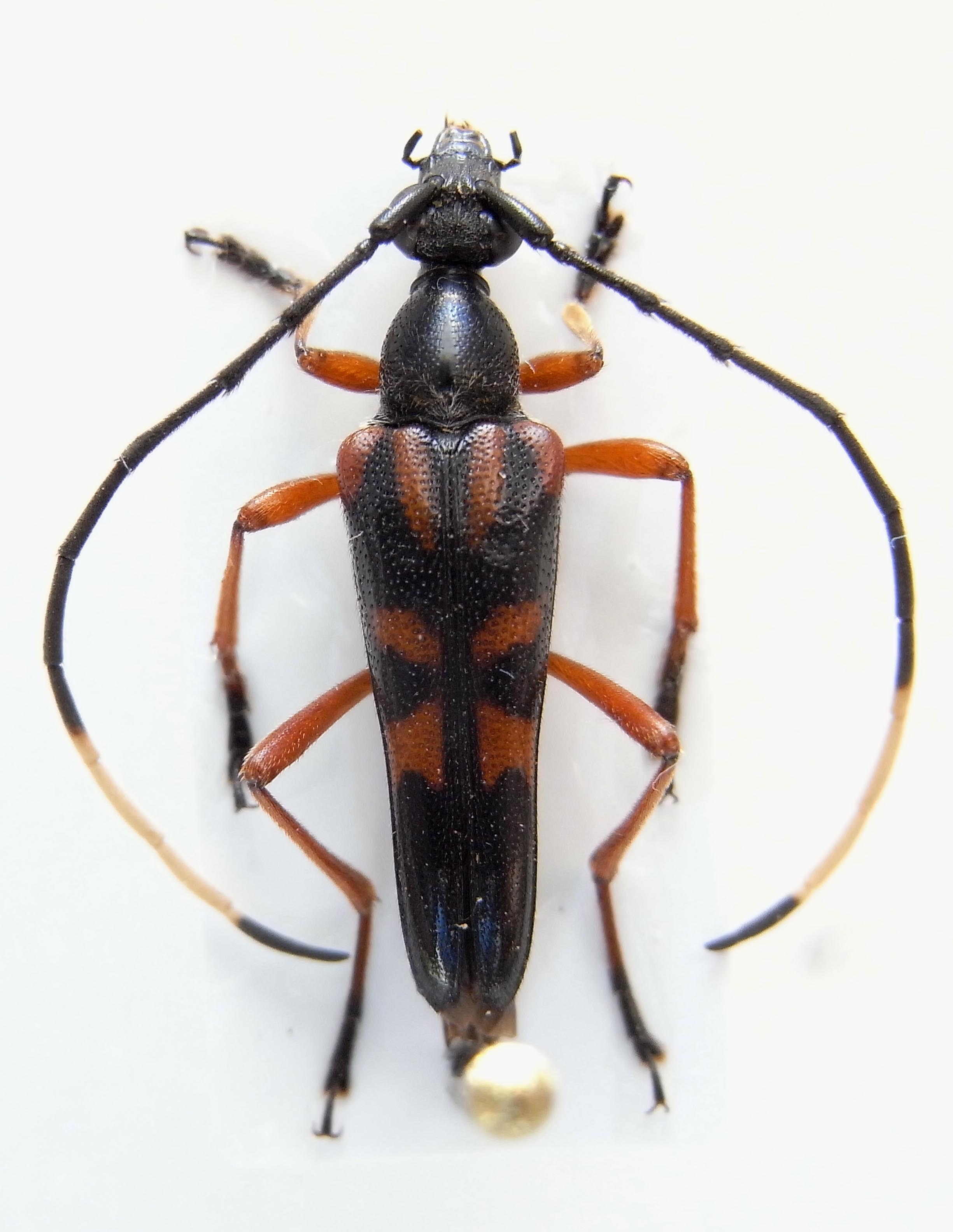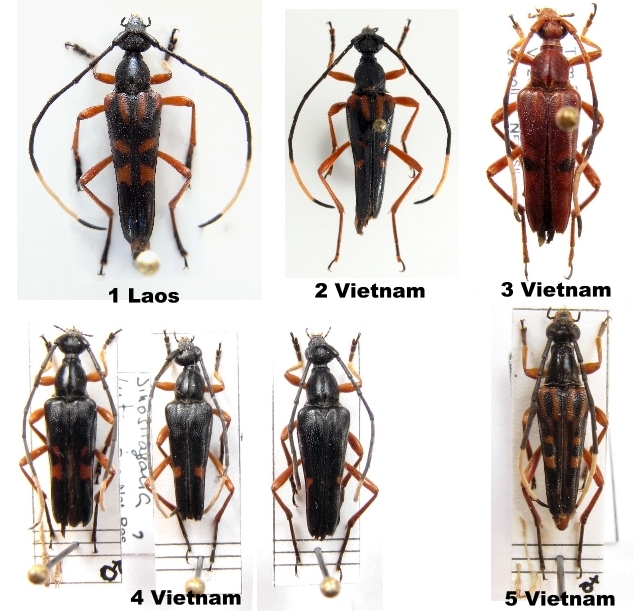| T O P I C R E V I E W |
| Xavier |
Posted - 02/11/2011 : 19:15:55

Nord-est du Laos. 15 mm, mâle.
Sinostrangalis yamasakii (Mitono, 1936) qui n'est pas dans la galerie.
J'ignore si cette espèce est connue du Laos. |
| 15 L A T E S T R E P L I E S (Newest First) |
| horshehden |
Posted - 02/01/2012 : 14:10:05
It seems to be very similar, but I'm not sure with the identity of both species. |
| Gerard |
Posted - 01/01/2012 : 16:13:32
Good morning to all my best sincere wishes for 2012.
Thanks for this interesting post, horshehden is number 2 Japanostrangalia clermonti in your opinion as the number 1? |
| Xavier |
Posted - 01/01/2012 : 15:14:48
Thanks a lot for this brilliant presentation.
I will try to collect more specimen in Laos next spring. |
| horshehden |
Posted - 01/01/2012 : 14:30:53
Well, I haven't seen the types and it is very difficult to guess what are the features of pronotum of "old" species according to their description.
It is probably the reason why there is - according to my knowledge - NO real taxonomic conclusion, ie. Chou & Ohbayashi, 2007 treated almost now specimens from mainland, except Sinostrangalis and two pictures of "J. basiplicata". However, these two pictures probably refer to two distinct species - elytra pattern and, more importantly, light segments of antennae are different.
I believe that the colour of antennae is very important in this group, as based on my experience with quite related genera, such as Parastrangalis and Ischnostrangalis.
Moreover, I have one specimen from Hunan, which has almost identical shape of pronotum, head and features of elytra as Taiwaneese Metastrangalis.
#5 must be Sinostrangalis ikedai. The only question is, what is the female??
#1 I would treat it as J. clermonti and #4 might be its variety.
Unfortunately, I only guess, since I have not seen the types or the types are damaged (without antennae) or lost so that you cannot make strong statement without deep revision (punctuation, penis, DNA from the type locality etc.)
Note, however, that C. Holzschuh regularly determines specimens from China (Sechuan, etc) with 3 fully light segments as J. clermonti.
|
| Francesco |
Posted - 31/12/2011 : 15:08:00

Thank you for your contribution horshehden.
In conclusion, I have collected all specimens present in this topic.
I agree concerning the belonging to the exx. 1-4 to the genus Japanostrangalia, but has this taxonomic change already been published?
Could you please identify all these species? |
| horshehden |
Posted - 31/12/2011 : 13:04:12
That's right, the species of Steve is Sinostrangalis ikedai... |
| Xavier |
Posted - 31/12/2011 : 12:32:17
Bonjour.
Pour moi, l'espèce de Steve Lingafelter n'est pas la même espèce (forme du pronotum). Celle de Gorodinski, qui n'a pas les tarses noirs (variation ?), appartient sans doute au même genre. |
| horshehden |
Posted - 31/12/2011 : 12:20:57
In my view, both identifications are incorrect - according to the original description, Pic's J. clermonti should have only two segments of antenna light and about a half of the preceding one, ie 8th in part, 9th & 10th fully.
By contrast, Fairmaire's J. basiplicata should have, again according to the original description, segment 8, 9, 10 fully light.
See also the photo of the type's male in Chou & Ohbayashi 2007.
Although the type is without antenna, elytra has almost the same colour as my specimens from China, as well as Gorodinski's photos.
Specimens from Laos and Vietnam with 8th segment partly light are of different elytral pattern. However, the picture of J. basiplicata from Vietnam in Chou & Ohbayashi 2007 is probably mistake - it might rather be J. clermonti.
Finally, let me stress that all the discussion (and photos) here concerns genus Japanostrangalia, but not Metastrangalis that should have, besides others, different pronotum. The only exception is one photo of Sinostrangalis ikedai. See again Chou & Ohbayashi 2007. |
| Gerard |
Posted - 31/12/2011 : 11:58:21
Bonjour Xavier, c'est sur ces deux sites:
1 site de Steve Lingafelter
2 site de Andre Gorodinski
Pour la taxonomie elle est sur Catalogue of Life. |
| Xavier |
Posted - 30/12/2011 : 23:47:26
Gérard, peux-tu nous dire où tu as trouvé une description de cette clermonti ? |
| Gerard |
Posted - 29/12/2011 : 19:48:42
Bonsoir Francesco j'ai peut être trouvé le nom de cette bête Sinostrangalis clermonti (Pic, 1927) donnée du Vietnam |
| Francesco |
Posted - 06/11/2011 : 18:40:23
Oui, mais je vois qu'ils ne sont pas allés au delà de Japanostrangalia... 
et ils ont raison, parce cette espèce me semble correspondre plus à ce genre, qui pourtant est endémique du Japon! |
| Xavier |
Posted - 06/11/2011 : 18:08:07
J'ai trouvé des images sur insect-fans qui montrent peut-être le même couple de >Strangalia< |
| Francesco |
Posted - 06/11/2011 : 12:45:39
J'ai un peu regardé BioLib et le Web, et je crois qu'il s'agit dans tous les cas de la même espèce: Metastrangalis thibetana.
Peut-être qu'il forme de sous-espèces ou de populations plus mélaniques en Vietnam... qui peut-être quelqu'un a déjà décrit.
A tel propos, il serait utile de trouver cet article: Chou W.I. & Ohbayashi N., 2007 - Notes on the genera Sinostrangalis and Metastrangalis (Coleoptera, Cerambycidae) [Studies on the Taiwanese Lepturinae, I] - Japanese Journal of systematic Entomology 13 (2). |
| Xavier |
Posted - 06/11/2011 : 11:29:22
Je ne vois pas de différence entre l'espèce de Gérard et la mienne : même ponctuation, même pronotum, même couleur des antennes. La couleur des tarses seulement est un peu différente. |
|
|


